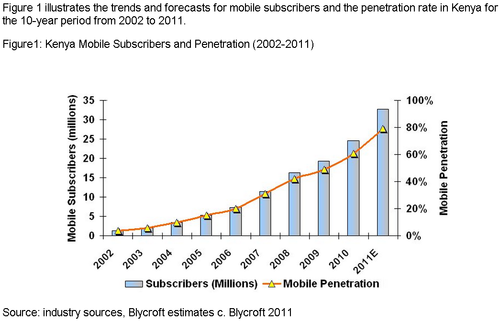Knowledge fuels change - Support energypedia!
For over 10 years, energypedia has been connecting energy experts around the world — helping them share knowledge, learn from each other, and accelerate the global energy transition.
Today, we ask for your support to keep this platform free and accessible to all.
Even a small contribution makes a big difference! If just 10–20% of our 60,000+ monthly visitors donated the equivalent of a cup of coffee — €5 — Energypedia would be fully funded for a whole year.
Is the knowledge you’ve gained through Energypedia this year worth €5 or more?
Your donation keeps the platform running, helps us create new knowledge products, and contributes directly to achieving SDG 7.
Thank you for your support, your donation, big or small, truly matters!
Mobile Phone Market in Kenya
Overview
Mobile Service provider Safaricom projected that the mobile phone market in Kenya would reach three million subscribers by 2020. The price of the cheapest mobile phone in Kenya costs half the average monthly income. Using firm-level data from the World Bank Enterprise Surveys for Kenya, Tanzania, and Uganda, we find that a large percentage of firms had already adopted mobile phones in 2003, ranging from 83% to 93% across these countries. This high level of adoption appears to be correlated with the poor quality of landline services.
Kenyan firms reported an average of 36 days of interrupted landline service per year, with interruptions lasting an average of 37 hours. Many firms also faced challenges in even obtaining landline service. On average, Kenyan firms had to wait 100 days to obtain landline service, with a majority of firms paying bribes to facilitate this connection. (The average bribe was reported to be worth US$117, compared with a GDP per capita of US$780). Thus, explicit and implicit landline costs could have provided powerful incentives for firms to adopt mobile phones.
While Kenyan firms rapidly adopted mobile phones, the individual adoption rate has been signifificantly lower. Using data from the FinAccess surveys, we examine some basic patterns of individual mobile phone adoption in Kenya. Between 2006 and 2009, the percentage of the Kenyan population with mobile phone coverage remained relatively static, but the number of subscriptions tripled reaching 17 million by 2009 (GSMA data for 2009). The adoption of mobile phone handsets increased by 74% during this period, from 27% in 2006 to 47% in 2009, as shown in Table 1.
One-third of Kenyans shared their mobile phones with friends or relatives, supporting qualitative evidence of free riding and the use of mobile phones as a common property resource in sub-Saharan Africa. At the same time, such patterns could also reflect cost-sharing, especially among poorer rural households for whom the cost of handsets and services is still prohibitively expensive. For these reasons, reported data on mobile phone subscriptions could signifificantly underestimate the number of mobile phone users; in fact, while only 47% of individuals owned a phone, 80% reported having access to a mobile phone through direct ownership or sharing.
Generating Additional Employment
Further Information
- Figure1: Kenya Mobile Subscribers and Penetration (2002-2011)[3]
- Table1: Summary Statistics of Mobile Phone Adoptionand Use in Kenya[4]
- Charging solutions for mobile phone




















